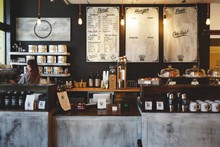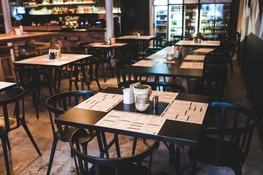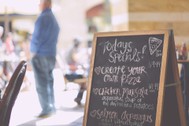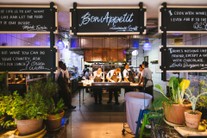Why is Menu Design Important?
Did you know that your restaurant’s menu design has the potential to directly impact sales and revenue?
Your menu is an advertisement for your restaurant. It’s an important selling tool. It goes without saying that it needs to be visually attractive and easy to read. That aside, it should also entice customers with its variety of dining options and appeal to their senses.
Little things like the color, design, placement of prices, and overall layout can have a subtle impact on your patron’s buying decision.
That’s why menu design can be a tricky thing to get right, and it’s not as simple as just putting some text on an image or two. It takes time and effort and a lot of thought to create something that looks good and works well for your restaurant. But if you do it right, the results will pay off in the long run.
What’s Menu Engineering?
Menu engineering is the science behind creating appealing menus that maximize profit.
It’s about understanding how people make decisions when they’re deciding what to eat at any given moment and influencing them to your advantage.
Also known as menu psychology, menu engineering is about using principles of human behavior to create a menu that sells your high-margin items effectively.
Menu Design Principles
A well-designed menu follows the principles of menu design – a set of practical guidelines that you must consider when designing menus. These include:
- Creating a great first impression
- Emphasizing your best sellers
- Using descriptive language to evoke emotions
- Choosing appropriate colors
Here are nine restaurant menu design tips to help you create the perfect menu:
1. Understand Your Target Audience
When designing your menu, it’s important to understand who you’re trying to attract with your food. Are you targeting families looking for healthy options? Or maybe you want to cater to more of a younger crowd? If you don’t know what type of people you’re catering to, you won’t have any idea where to start when creating your menu.
For example, if your Restaurant is located on the beachfront, your customer base will be very relaxed. Thus a good idea would be to sell foods that are easily edible by hand, like perhaps gourmet burgers or fancy ice cream. This type of menu and dining experience would be favourable to customers in this area and would increase sales.
2. Determine Menu Cost and Selling Prices
You need to keep menu prices within the budget of your target market while maintaining quality.
There are a few ways to achieve a good balance between cost and quality.
Firstly, try to keep portion sizes on the smaller side at a reasonable price. Remember that quality beats quantity every time. For more information and data on the benefits of serving small portion sizes in restaurants check out our article.
Include cheaper value-adding fillers. You don’t have to load the plate with the most expensive item in the recipe. Limit the expensive ingredients and fill the plate with a mix of salad, chips, vegetables, etc. Having multiple options for each dish generally adds to customer satisfaction.
Remember to compare prices from different suppliers to ensure that you get the best quality ingredients at the lowest cost.
Don’t forget to sneak a peek at your competition’s menu and selling prices when designing your own menu. Try to keep your prices in line with those of your competitors.
Make your most profitable item prominently visible
Your most profitable items should be placed on the menu in a way that catches the user’s attention. Menu engineering expert, Gregg Rapp, suggests that the upper right corner of the menu is the most ideal spot for getting attention. The placement, fonts, color scheme should be enticing enough to draw users’ eyes to your most profitable dishes.
Avoid using the dollar sign
The dollar sign may have an unconscious effect on your customer making him price-conscious. That’s why you should eliminate all types of currency signs from your menu.
3. Design the Menu Layout and Sections
Choose Your Menu Style and Menu Design
Design the layout of your menu by incorporating the principles of menu engineering. You also need to consider the “look” of your restaurant menu and how this will be received by your guests. Your menu should be easy to read and serve as a sales tool.
There are a variety of design programs you can use to create your restaurant menu design, such as Canva. You can use predesigned templates, so it’s as easy as copying and pasting.
Use Visual Hierarchy & Color Theory
Visual hierarchy refers to the order in which elements appear on a page. In terms of menu design, visual hierarchy is used to determine how much space certain parts of the menu take up.
The most important element on the menu should be placed first. After that comes the second most important part of the menu, followed by other less important elements.
Color theory is another tool that helps you create visually appealing menus. It allows you to use colors effectively to enhance the overall look of your menu. F
Menu color scheme
The color scheme to make the design layout attractive. You might want it to match your décor but not overwhelm or compete with it.
Use Bold Colors For A Fun And Informative Look
If you’re looking to make your menu stand out from others, then bright colors like yellow, orange, and red might be the way to go. They give your menu a unique look and feel, while also titillating your customers.
Colors like red, yellow, and orange draw attention and stimulate appetite. In addition to creating a hierarchy for your layout, this can also be used to draw attention to specific areas of your menu.
Colors can evoke emotions and feelings. Be sensitive to the use of too many colors.
Also, make sure that you use ample use of white space to avoid clutter and distraction. White space also gives the menu a clean look while allowing your customers to smoothly process the information on the menu.
Make your menu scannable
Your menu’s design should be easy on the eyes. A cluttered menu is going to create fiction in your customer’s mind. Your font style and size should be clear and legible.
Keep your fonts simple and avoid using too many fonts. Use only one font per section. If you’re unsure about what font to use, consult a freelance graphic designer.
Avoid using too much text in your menu. Keep your menu description concise and remember that people scan them quickly.
The fewer words there are on your menu, the easier it is to understand.
Avoid using too many images or graphics on your menu. This can distract customers and make reading difficult. Also, it’s a good idea to limit choices to around seven items in each category.
Also, ensure that your most profitable items are prominently placed on the menu.
When designing menus, it’s always best to keep everything working together. This means keeping all of your fonts, images, and copy consistent throughout the entire piece. If there are too many things that aren’t matching up, it can throw off the overall look of your menu.
4. Communicate Your Brand Personality
Your menu should represent your brand’s personality. It should reflect who you are and what makes you special. Ask yourself questions like:
- Do you want to convey a sense of fun?
- What do you want your customers to think about when they see your menu?
- How does your menu fit into your business?
- How do you want your customers’ experience to be?
Think about how you want to portray your brand’s personality through your menu.
The personality of your menu should come across no matter what. Whether it’s through the font choice, color scheme, or even the layout itself, you should be able to tell at first glance whether you’re dealing with a professional company or someone who doesn’t care about their work.
Make your menu memorable
While it’s great to include a lot of information on your menu, you shouldn’t forget to remember why you created it in the first place. If you want to make sure your customers remember you, then make sure that your menu has something memorable to offer.
Be Creative But Realistic
If you plan to have an extravagant menu you need to make sure that your chef can successfully prepare the dishes you want to serve. A mouth-watering menu means nothing if the meals don’t meet the client’s expectations. The dishes on your menu should be easy and quick to prepare.
5. Plan for Waste
Waste is inevitable, however, it can be managed effectively. While costing a menu it is important to consider methods to reduce waste.
Try to keep your menu small and use perishable ingredients in multiple recipes. By doing this, perishable goods will be used more frequently – reducing waste.
Another method to reduce waste would be to implement the “FIFO” Method (First In First Out). The oldest produce should always be used first before fresh goods are used.
Reducing waste can be simplified by using Cloud Inventory Software. For example, the No Spoilers innovative tools give staff easy access to loss reporting (breakage and waste), as well as enable them to monitor open and closed containers based on active sales. This way you know what stock you have and what’s going on in your restaurant in real-time.
We hate waste and minimizing it is a huge priority for us. If you need more tips and tricks to minimize your restaurant waste, you can find them in our recent article.
6. Plan for Special Menu Offers
Keep a spot open on your menu for special offers. Running regular specials is a great way to attract clients. Specials are also ideal to get rid of ingredients that are approaching their expiry date.
If you are considering a new menu item, add it to your specials and check to see if clients like it before adding it to your menu.
A final bonus: by creating specials you might attract new clients and create more awareness of your Restaurant.
7. Be Consistent in your online menu and instore menu
One of the most common mistakes made by new designers is having inconsistent menus. While this may seem like a minor detail, it can really take away from the overall look of your website.
8. Use a Menu Maker Software or Tool
If you don’t have that creative bent to design a menu, there are plenty of options available to help you out. There are many free software programs that allow you to easily create menus. You can choose a menu template and do some customization to suit your needs.
Most of these programs are very simple to use, but some require a bit of training.
9. Stay on Top of Food Trends
It is essential to keep your menu trendy and up to date! Be creative with the dishes on your menu and consider hiring a creative writer to describe your dishes in a way that makes your clients’ mouths water.
Also, make sure that your meals look delicious when they are presented to clients. People eat with all their senses so it is important that each dish you create looks, tastes, and smells fantastic!
Staying on top of restaurant trends in terms of technology food will ensure repeat customers.
Final Thoughts
By following these basic guidelines you will be able to create the ideal menu for your Restaurant. Remember to keep your costing up to date. Once in a while have a look at your menu to remove unpopular dishes and replace them with trendy new ones. Having the right software will help you manage your inventory, staff, and restaurant in general.
While costing and creating the perfect menu can be daunting, the end result is equally rewarding. Allow yourself to create more than just a menu, create an experience that will leave your clients wanting more!









